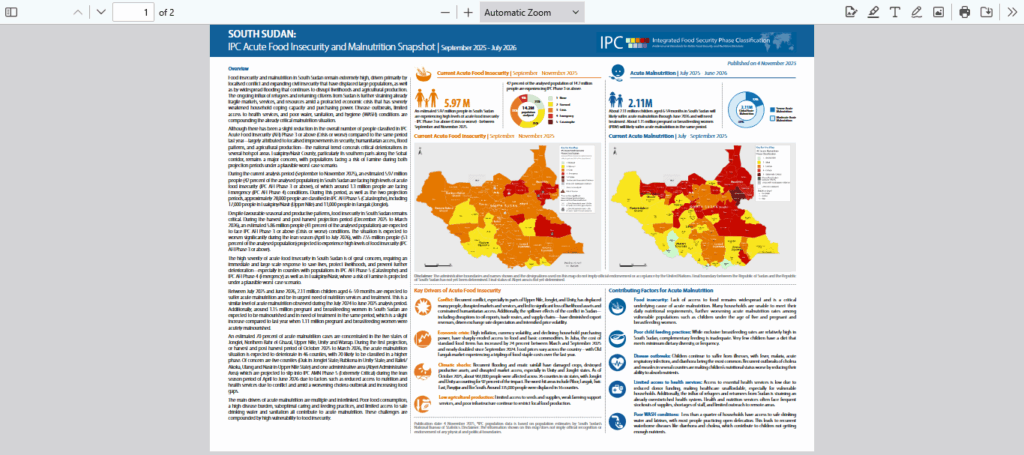The latest Integrated Food Security Phase Classification (IPC) report of the United Nations, released on Tuesday, revealed that food insecurity and malnutrition in South Sudan remain extremely high, driven primarily by localised conflict and expanding civil insecurity that have displaced large populations, as well as by widespread flooding that continues to disrupt livelihoods and agricultural production.
According to the IPC report, the ongoing influx of refugees and returning citizens from Sudan is further straining already fragile markets, services, and resources amid a protracted economic crisis that has severely weakened household coping capacity and purchasing power. Disease outbreaks, limited access to health services, and poor water, sanitation, and hygiene (WASH) conditions are compounding the already critical malnutrition situation. The UN warned that the severe food and nutrition crisis will deteriorate further unless urgent humanitarian action is taken.
“Although there has been a slight reduction in the overall number of people classified in IPC Acute Food Insecurity (AFI) Phase 3 or above (Crisis or worse) compared to the same period last year – largely attributed to localised improvements in security, humanitarian access, flood patterns, and agricultural production – the national trend conceals critical deteriorations in several hotspot areas,” the IPC report reads in part. “Luakpiny/Nasir County, particularly its southern parts along the Sobat corridor, remains a major concern, with populations facing a risk of Famine during both projection periods under a plausible worst-case scenario.”
“During the current analysis period (September to November 2025), an estimated 5.97 million people (42 percent of the analysed population) in South Sudan are facing high levels of acute food insecurity (IPC AFI Phase 3 or above), of which around 1.3 million people are facing Emergency (IPC AFI Phase 4) conditions,” the report adds.
During this period, as well as the two projection periods, approximately 28,000 people are classified in IPC AFI Phase 5 (Catastrophe), including 17,000 people in Luakpiny/Nasir (Upper Nile) and 11,000 people in Fangak (Jonglei).
Despite favourable seasonal and productive patterns, food insecurity in South Sudan remains critical. During the harvest and post-harvest projection period (December 2025 to March 2026), an estimated 5.86 million people (41 percent of the analysed population) are expected to face IPC AFI Phase 3 or above (Crisis or worse) conditions. The situation is expected to worsen significantly during the lean season (April to July 2026), with 7.55 million people (53 percent of the analysed population) projected to experience high levels of food insecurity (IPC AFI Phase 3 or above).
According to the report, the high severity of acute food insecurity in South Sudan is of great concern, requiring an immediate and large-scale response to save lives, protect livelihoods, and prevent further deterioration – especially in counties with populations in IPC AFI Phase 5 (Catastrophe) and IPC AFI Phase 4 (Emergency) as well as in Luakpiny/Nasir, where a risk of Famine is projected under a plausible worst-case scenario.
Between July 2025 and June 2026, 2.11 million children aged 6–59 months are expected to suffer acute malnutrition and be in urgent need of nutrition services and treatment. This is a similar level of acute malnutrition observed during the July 2024 –June 2025 analysis period. Additionally, around 1.15 million pregnant and breastfeeding women in South Sudan are expected to be malnourished and in need of treatment in the same period, which is a slight increase compared to last year, when 1.11 million pregnant and breastfeeding women were acutely malnourished.
An estimated 70 percent of acute malnutrition cases are concentrated in the five states of Jonglei, Northern Bahr el Ghazal, Upper Nile, Unity, and Warrap. During the first projection, or harvest and post-harvest period of October 2025 to March 2026, the acute malnutrition situation is expected to deteriorate in 46 counties, with 20 likely to be classified in a higher phase.
During the second projection, or lean season period of April to June 2026, the severity of acute malnutrition is expected to deteriorate in 69 counties, remain similar in nine counties, and improve in two counties (Ayod in Jonglei and Aweil South in Northern Bahr el Ghazal). Four other counties will deteriorate further within IPC AMN Phase 5 (Extremely Critical), whereas Duk is expected to remain at a similar level of severity within IPC AMN Phase 5. However, a further deterioration into IPC AMN Phase 5 (Extremely Critical) is expected for four counties: Ulang, Nasir, Baliet/Akoka in Upper Nile, and Rubkona in Unity State. Urgent treatment and multisectoral interventions are needed to save the lives of the affected children.
The IPC listed the key drivers for acute food insecurity as recurrent conflict, displacement, economic crisis, climatic shocks, and food insecurity.
Conversely, the IPC listed the contributing factors of acute malnutrition as food insecurity, poor child feeding practices, disease outbreaks, limited access to health services, and poor WASH conditions.
Download full report here: https://www.ipcinfo.org/fileadmin/user_upload/ipcinfo/docs/IPC_South_Sudan_Acute_Food_Insecurity_Malnutrition_Sep2025_July2026_Report.pdf




